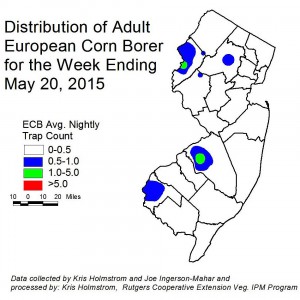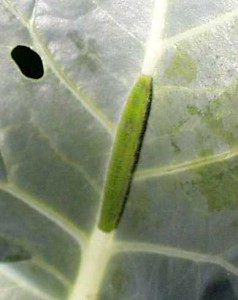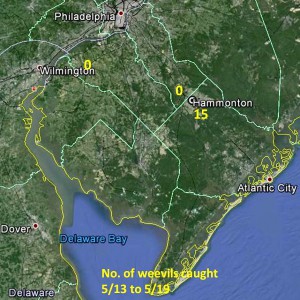Sweet Corn
European corn borer (ECB) adults are being captured with increasing frequency now. At the present, areas of highest activity include Burlington and Warren counties (see ECB map). Cooler nights for later this week may suppress catches for the next several days.Most early sweet corn plantings are too young to support ECB larval infestations. However, over the next two weeks we should begin to see feeding in the most advanced plantings. Be sure to begin monitoring the earliest plantings for ECB feeding while they are still in the whorl stage. For detailed information see:
| The highest nightly ECB catches for the previous week are as follows: | ||
| Belvidere 2 | Allamuchy 1 | Port Colden 1 |
| Blairstown 2 | Califon 1 | Sergeantsville 1 |
| Denville 2 | Centerton 1 | Tabernacle 1 |
| Medford 2 | Pedricktown 1 | Woodstown 1 |
Two corn earworm moths (CEW) were captured in blacklight traps this past week. These individuals were at Centerton and East Vineland.
Cole Crops
Infestations of imported cabbage worm (ICW) are occurring at this time. Scout plantings weekly. Check 5 consecutive plants each in 10 random locations throughout the planting, paying particular attention to the innermost leaves where ICW often feed. Consider treating if caterpillars are found on 10% or more plants that are in the 0-9 true leaf stage. From 9-leaf to the early head stage (in broccoli, cauliflower and cabbage) infestations up to 20% may be tolerated. Once heads begin to form, a 5% threshold should be observed to protect the marketable portion of the plant. For leafy greens such as collards and kale, 10% plants infested is the threshold throughout.
Although none have been discovered yet, it is not too soon to begin preparing for infestations of diamondback moth (DBM) larvae. Some populations of DBM are resistant to carbamate and synthetic pyrethroid insecticides. The lack of DBM control with these insecticides has been noted in NJ previously. It is important to distinguish between common cole crop pests for this reason. DBM larvae grow to a length of approximately 0.5”, and taper toward both ends. These caterpillars thrash violently when disturbed. ICW grow to a length of approximately 1.25” and are covered with short hairs. Newer chemistries that specifically target caterpillar pests are effective against DBM as well as all other caterpillar pests of cole crops. These materials include (active ingredient – trade name (IRAC* code)):
Spinosad/Spinetoram – Entrust/ Radiant (5)
Chlorantraniliprole – Coragen (28)
Cyantraniliprole – Exirel (28)
Flubendiamide – Synapse (28)
The IRAC group 5 insecticide, Entrust, is OMRI approved for organic production. Insecticides based on the soil inhabiting bacterium Bacilllus thuriengensis (B.t.) may also be effective on caterpillar pests of cole crops. Examples include Xentari and Javelin. These materials are also OMRI approved. If B.t. materials are used, they must target smaller larvae. Do not wait until large larvae are dominant the field, as results may be unsatisfactory. An added benefit of all the aforementioned chemicals is that they have minimal impact on non-target species, including many insect predators and parasites. Spinosad materials should be used in a way that avoids contact with bees.
Tomatoes
Many early tomato plantings are now in the field. Pruning and tying of plants is on-going. Remember that any event that results in contact with the plant causes numerous injuries to them. While these injuries heal, they serve as avenues of entry for bacterial pathogens that may be present either on the plants or in the field. Serious bacterial pathogens of tomato include bacterial leaf spot and bacterial canker. Both can result in unmarketable fruit, and canker can kill plants prior to the production of fruit if the infection occurs early enough. Timing and rates for applications of copper and/or the plant defense activator Actigard are detailed in the 2015 Commercial Vegetable Production Recommendations. These products provide some suppression of bacterial pathogens. It is critical, however, that spread of bacterial organisms be limited as much as possible. Avoid working in fields when plants are wet. When work is to be done in more than one planting, always work from youngest to oldest plants. This prevents workers from transporting bacteria to younger plants, where infections can result in increased crop loss. Remember that the earlier a plant is infected by a bacterial pathogen, the more likely it is to produce unmarketable fruit.
Two-spotted spider mite (TSSM) infestations have recently been discovered in a high tunnel in Middlesex County. TSSM feeding results in small white pin-spots on the upper leaf surface. Mites are actually underneath leaves. These pests can increase dramatically in the warm, dry environment of the tunnel. Check 5 plants each in 5 separate locations in the tunnel. Inspect the entire plant, and be sure to check the underside of leaves that display the whitish mite feeding. If mites are found, it is best to immediately treat. TSSM is much more easily managed, when the problem is addressed at low levels. If allowed to spread throughout the tunnel, TSSM will be much more difficult to control. See the 2015 Commercial Vegetable Production Recommendations for materials that are labeled for use in greenhouse structures. It may be possible to deploy predatory mites such as Neoseiuilus falacis or Neoseiulus californicus in the tunnel to limit TSSM populations. This and other TSSM predators may be purchased from bio-control suppliers such as Koppert. The main drawback of this strategy is that predatory mites generally have much lower tolerance for heat than TSSM. Therefore, if outside weather is routinely exceeding 80°F, and the tunnel temperature is exceeding 85°F during the day, it is unlikely that predatory mites will survive long enough to have a significant impact on TSSM.
Aphid populations have also begun to appear in high tunnel tomatoes. These pests often form colonies beneath the surface of leaves and near growing points on the plant. While the plants consist primarily of vegetative growth without fruit, aphids are largely an insignificant pest. If no broad spectrum insecticides are used on the plants, the aphids generally are decimated by predators and parasites before becoming an economic problem. Should aphid populations increase to a degree that their droppings are accumulating on the surface of developing fruit, an insecticide that specifically targets these pests may be necessary. See the 2015 Commercial Vegetable Production Recommendations for materials that are labeled for aphid control in tomatoes. Avoid broad spectrum insecticide classes such as synthetic pyrethroids as much as possible.
Brown Marmorated Stink Bug (BMSB)
To date, only a few scattered BMSB individuals have been captured in the blacklight network. As levels in any area rise to an average of above 1/night, a population map of this insect’s activity will appear in this publication.
Pepper Weevil
Joe Ingerson-Mahar reports that, although pepper weevil catches in the southern NJ weevil trap network are generally lower than in previous seasons, there was a recent spike in activity in the Hammonton area (see pepper weevil map). Reports on this insect’s activity will appear in the Plant and Pest Advisory on a weekly basis, with relevant control information.




